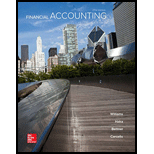
Financial Accounting
17th Edition
ISBN: 9781259692390
Author: Jan Williams, Susan Haka, Mark S Bettner, Joseph V Carcello
Publisher: McGraw-Hill Education
expand_more
expand_more
format_list_bulleted
Question
Chapter 2, Problem 6E
To determine
Indicate the effect of each of the transactions on the total amounts of the company’s assets, liabilities, and owners’ equity and use code letters I for increase, D for decrease, and NE for no effect.
Expert Solution & Answer
Want to see the full answer?
Check out a sample textbook solution
Students have asked these similar questions
Elba Industries recently reported an EBITDA of $12.5 million and a net income of $3.7 million. It had $3.2 million in interest expense, and its corporate taxrate was 40%. What was its charge for depreciation and amortization?
Pedro Manufacturing expects overhead costs of $360,000 per year
and direct production costs of $15 per unit. The estimated
production activity for the 2023 accounting period is as follows:
1st 2nd 3rd 4th
Quarter
Units Produced 10,000 9,500 8,000 10,500|
The predetermined overhead rate based on units produced is
(rounded to the nearest penny):
a. $9.47 per unit
b. $10.00 per unit
c. $8.05 per unit
d. $11.25 per unit
Please provide the answer to this general accounting question with proper steps.
Chapter 2 Solutions
Financial Accounting
Ch. 2 - Prob. 1STQCh. 2 - Prob. 2STQCh. 2 - Prob. 3STQCh. 2 - Prob. 4STQCh. 2 - Prob. 5STQCh. 2 - Prob. 6STQCh. 2 - Prob. 7STQCh. 2 - Prob. 8STQCh. 2 - Prob. 1DQCh. 2 - Prob. 2DQ
Ch. 2 - Prob. 3DQCh. 2 - Prob. 4DQCh. 2 - Prob. 5DQCh. 2 - Prob. 6DQCh. 2 - Prob. 7DQCh. 2 - Prob. 8DQCh. 2 - Prob. 9DQCh. 2 - Prob. 10DQCh. 2 - Prob. 11DQCh. 2 - Prob. 12DQCh. 2 - Prob. 13DQCh. 2 - Prob. 14DQCh. 2 - Prob. 15DQCh. 2 - Prob. 1BECh. 2 - Prob. 2BECh. 2 - Prob. 3BECh. 2 - Prob. 4BECh. 2 - Prob. 5BECh. 2 - Prob. 6BECh. 2 - Prob. 7BECh. 2 - Prob. 8BECh. 2 - Prob. 9BECh. 2 - Prob. 10BECh. 2 - Prob. 1ECh. 2 - Prob. 2ECh. 2 - Prob. 3ECh. 2 - Prob. 4ECh. 2 - Prob. 5ECh. 2 - Prob. 6ECh. 2 - Prob. 7ECh. 2 - Prob. 8ECh. 2 - Prob. 9ECh. 2 - Prob. 10ECh. 2 - Prob. 11ECh. 2 - Prob. 12ECh. 2 - Prob. 13ECh. 2 - Prob. 14ECh. 2 - Prob. 15ECh. 2 - Prob. 16ECh. 2 - Prob. 17ECh. 2 - Prob. 1PACh. 2 - Prob. 2PACh. 2 - Prob. 3PACh. 2 - Prob. 4PACh. 2 - Prob. 5PACh. 2 - Prob. 6PACh. 2 - Prob. 7PACh. 2 - Prob. 8PACh. 2 - Prob. 9PACh. 2 - Prob. 10PACh. 2 - Prob. 1PBCh. 2 - Prob. 2PBCh. 2 - Prob. 3PBCh. 2 - Prob. 4PBCh. 2 - Prob. 5PBCh. 2 - Prob. 6PBCh. 2 - Prob. 7PBCh. 2 - Prob. 8PBCh. 2 - Prob. 9PBCh. 2 - Prob. 10PBCh. 2 - Prob. 1CTCCh. 2 - Prob. 2CTCCh. 2 - Prob. 3CTCCh. 2 - Prob. 4CTCCh. 2 - Prob. 5CTCCh. 2 - Prob. 6CTC
Knowledge Booster
Similar questions
- Hello tutor please given General accounting question answer do fast and properly explain all answerarrow_forwardOn March 1, 20X1, your company,which uses Units-of-Production (UOP) Depreciation, purchases a machine for $300,000.arrow_forwardPlease provide the accurate answer to this general accounting problem using valid techniques.arrow_forward
arrow_back_ios
SEE MORE QUESTIONS
arrow_forward_ios
Recommended textbooks for you

 AccountingAccountingISBN:9781337272094Author:WARREN, Carl S., Reeve, James M., Duchac, Jonathan E.Publisher:Cengage Learning,
AccountingAccountingISBN:9781337272094Author:WARREN, Carl S., Reeve, James M., Duchac, Jonathan E.Publisher:Cengage Learning, Accounting Information SystemsAccountingISBN:9781337619202Author:Hall, James A.Publisher:Cengage Learning,
Accounting Information SystemsAccountingISBN:9781337619202Author:Hall, James A.Publisher:Cengage Learning, Horngren's Cost Accounting: A Managerial Emphasis...AccountingISBN:9780134475585Author:Srikant M. Datar, Madhav V. RajanPublisher:PEARSON
Horngren's Cost Accounting: A Managerial Emphasis...AccountingISBN:9780134475585Author:Srikant M. Datar, Madhav V. RajanPublisher:PEARSON Intermediate AccountingAccountingISBN:9781259722660Author:J. David Spiceland, Mark W. Nelson, Wayne M ThomasPublisher:McGraw-Hill Education
Intermediate AccountingAccountingISBN:9781259722660Author:J. David Spiceland, Mark W. Nelson, Wayne M ThomasPublisher:McGraw-Hill Education Financial and Managerial AccountingAccountingISBN:9781259726705Author:John J Wild, Ken W. Shaw, Barbara Chiappetta Fundamental Accounting PrinciplesPublisher:McGraw-Hill Education
Financial and Managerial AccountingAccountingISBN:9781259726705Author:John J Wild, Ken W. Shaw, Barbara Chiappetta Fundamental Accounting PrinciplesPublisher:McGraw-Hill Education


Accounting
Accounting
ISBN:9781337272094
Author:WARREN, Carl S., Reeve, James M., Duchac, Jonathan E.
Publisher:Cengage Learning,

Accounting Information Systems
Accounting
ISBN:9781337619202
Author:Hall, James A.
Publisher:Cengage Learning,

Horngren's Cost Accounting: A Managerial Emphasis...
Accounting
ISBN:9780134475585
Author:Srikant M. Datar, Madhav V. Rajan
Publisher:PEARSON

Intermediate Accounting
Accounting
ISBN:9781259722660
Author:J. David Spiceland, Mark W. Nelson, Wayne M Thomas
Publisher:McGraw-Hill Education

Financial and Managerial Accounting
Accounting
ISBN:9781259726705
Author:John J Wild, Ken W. Shaw, Barbara Chiappetta Fundamental Accounting Principles
Publisher:McGraw-Hill Education